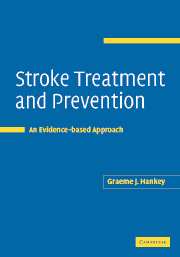Book contents
- Frontmatter
- Contents
- Preface
- 1 The size of the problem of stroke
- 2 Understanding evidence
- 3 Organised acute stroke care
- 4 General supportive acute stroke care
- 5 Reperfusion of ischaemic brain by thrombolysis
- 6 Augmentation of cerebral blood flow: fibrinogen-depleting agents, haemodilution and pentoxifylline
- 7 Neuroprotection
- 8 Treatment of brain oedema
- 9 Anticoagulation
- 10 Antiplatelet therapy
- 11 Carotid artery revascularisation
- 12 Lowering blood pressure
- 13 Lowering blood cholesterol concentrations
- 14 Modification of other vascular risk factors and lifestyle
- 15 Antithrombotic therapy for preventing recurrent cardiogenic embolism
- 16 Arterial dissection and arteritis
- 17 Treatment of intracerebral haemorrhage
- 18 Treatment of subarachnoid haemorrhage
- References
- Index
5 - Reperfusion of ischaemic brain by thrombolysis
Published online by Cambridge University Press: 23 December 2009
- Frontmatter
- Contents
- Preface
- 1 The size of the problem of stroke
- 2 Understanding evidence
- 3 Organised acute stroke care
- 4 General supportive acute stroke care
- 5 Reperfusion of ischaemic brain by thrombolysis
- 6 Augmentation of cerebral blood flow: fibrinogen-depleting agents, haemodilution and pentoxifylline
- 7 Neuroprotection
- 8 Treatment of brain oedema
- 9 Anticoagulation
- 10 Antiplatelet therapy
- 11 Carotid artery revascularisation
- 12 Lowering blood pressure
- 13 Lowering blood cholesterol concentrations
- 14 Modification of other vascular risk factors and lifestyle
- 15 Antithrombotic therapy for preventing recurrent cardiogenic embolism
- 16 Arterial dissection and arteritis
- 17 Treatment of intracerebral haemorrhage
- 18 Treatment of subarachnoid haemorrhage
- References
- Index
Summary
Rationale
About 80% of all strokes are caused by occlusion of a cerebral artery, resulting in focal brain infarction (ischaemic stroke) (Warlow et al., 2000). The cause is usually in situ atherothrombosis or an embolus from a proximal source such as the extracranial neck vessels, the aortic arch, the heart, and the leg and pelvic veins.
When a thrombus forms or is lodged in an artery, plasminogen, a precursor of plasmin, becomes trapped among the fibrin strands that constitute the bulk of the thrombus. Endogenous tissue plasminogen activator (t-PA), which is naturally made by endothelial cells, cleaves plasminogen on the surface of the thrombus, thereby releasing active plasmin. The plasmin, in turn, begins to degrade fibrin and thus expose more plasminogen. The process continues until the thrombus is lysed. Frequently, such spontaneous lysis of the thrombus, and recanalisation of the artery, do not occur until after the ischaemic brain has become infarcted.
Exogenous thrombolysis (or perhaps more correctly, fibrinolysis) aims to rapidly restore blood flow by lysing fresh thrombi (in situ or embolic) which underpin many, but not all, ischaemic strokes, before the ischaemic brain has become infarcted. However, although some emboli consist of fresh thrombus, which is lysable by thrombolysis, others are other non-lysable substances such as organised thrombus, calcium, bacteria, tumour and prosthetic material. Hence, not all ischaemic stroke is likely to respond to reperfusion by thrombolysis.
Thrombolysis has been used sporadically for more than 40 years in the treatment of acute ischaemic stroke (indeed, in the pre-computerised tomography (pre-CT) era, for the treatment of acute stroke of uncertain pathological type). However, evidence for its effectiveness and safety has only recently become available (Wardlaw et al., 2003, 2004).
- Type
- Chapter
- Information
- Stroke Treatment and PreventionAn Evidence-based Approach, pp. 87 - 119Publisher: Cambridge University PressPrint publication year: 2005



